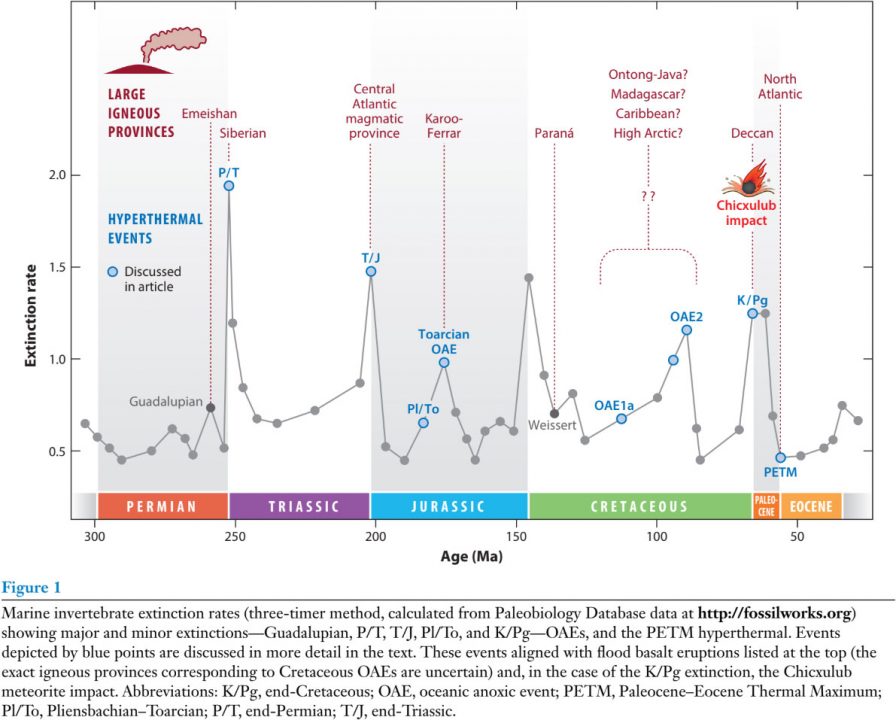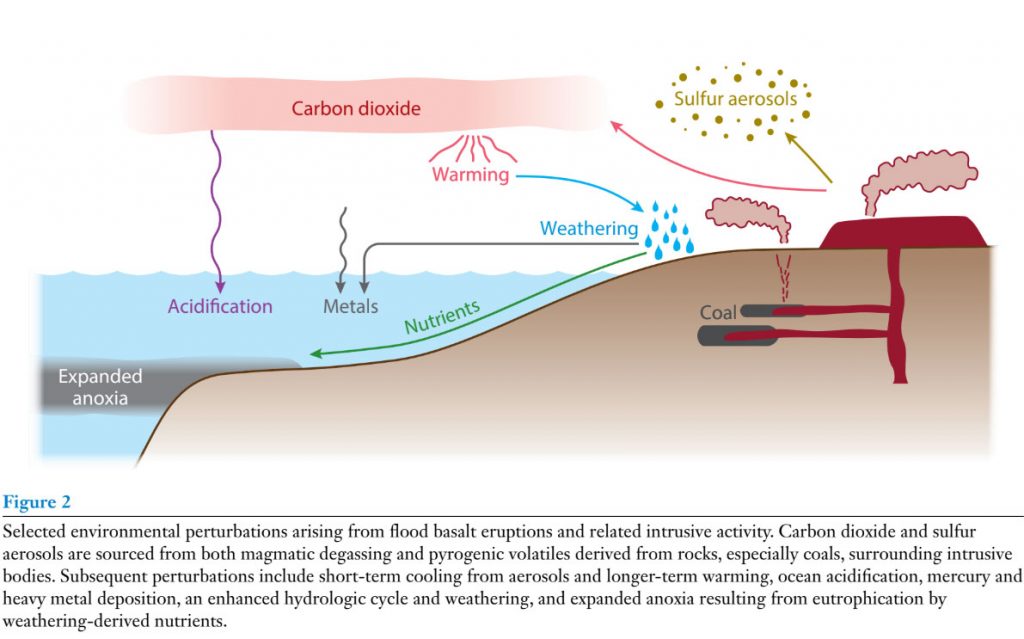Extinction Events in Earth History and Today
Flood basalts and mass extinctions – ancient hyperthermals as analogs for anthropogenic climate change.
Oceanic Anoxic Event (OAE) and mass extinctions are considered to be hyperthermals – usually associated with flood basalt eruptions.[2] Phases of rapid global warming, known collectively as hyperthermals.[1]
Flood basalts are a subset of large igneous provinces (LIPs), the terms flood basalt and LIP are often used interchangeably, although the former should be reserved for the extrusive component of an LIP. Flood basalts are giant volcanic eruptions or series of eruptions that cover large stretches of land or the ocean floor with basalt lava.
- Flood basalts, the largest volcanic events in Earth history, triggered dramatic environmental changes on land and in the oceans.
- Rapid volcanic carbon emissions led to ocean warming, acidification, and deoxygenation that often caused widespread animal extinctions.
- Animal physiology played a key role in survival during flood basalt extinctions, with reef builders such as corals being especially vulnerable.
- The rate and duration of volcanic carbon emission controlled the type of environmental disruption and the severity of biological extinction.
Study the parallels between hyperthermals and current climate change is by finding a suitable analogue – that is, the hyperthermal that was most similar to the kind of global warming that we’re seeing today.
Carbon input during the PETM was likely still 10 times as slow as in the modern era. Indicators of PETM ocean acidification demonstrate strong dissolution, but modern rates are faster.
The build up period that led to the PETM, in which around 3tn tonnes of CO2 was released into to the atmosphere, may have taken thousands of years. In comparison, the onset of current climate change has taken less than two centuries.
Research suggests that the rate of carbon release as a result of human-driven climate change, and its resultant effect on the world’s oceans, could be “completely unprecedented”.[1]
The rate of volatile emission, and therefore the rate of environmental disruption, likely provided a first-order constraint. In a sense, each hyperthermal extinction may have hardened ecosystems to be less vulnerable to future events.
CO2 is partially taken up by dissolving into the surface ocean, causing a negative C isotope excursion at most events.
However, the consensus today has shifted somewhat towards nutrient runoff (and eutrophication) as the primary driver, rather than slowing ocean circulation. This may also be related to different continental configurations hundreds of millions of years ago.
Flood basalts, are giant volcanic eruptions or series of eruptions that cover large stretches of land or the ocean floor with basalt lava.
Phases of rapid global warming, known collectively as hyperthermals, include episodes of Oceanic Anoxic Events (OAE), and subsequent extinctions.
Hyperthermals were characterized by enhanced chemical weathering and likely also by intensification of the hydrological cycle, supplying more nutrients that would drive eutrophication and expanded anoxia in shallow waters. However, despite the hyperthermals sharing a common history, the specific patterns of environmental change differed dramatically among them.
During the past mass extinctions, flood basalts released initial carbon dioxide, triggering climate warming, decreased ocean PH, and potentially decreased the carbonate saturation state, with subsequent weathering feedbacks leading to nutrient loading (eutrophication) and expansion of low-oxygen zones in the ocean.
This deoxygenation was driven primarily by nutrient loading that led to eutrophication and expansion of oxygen-minimum zones. On land, emission of sulfur dioxide (SO2) aerosols would likely have caused short-term cooling following each eruption, with longer-term warming from CO2. [2]
Extinction events

Mechanisms
Organism stressors
- Temperature
- Ocean acidification (Reduced PH)
- Deoxygenation (extreme condition in Ocean, leading to hydrogen sulfide production)
- Mercury loading
- Increased dissolved seawater CO2
Multiple stressors can have synergistic impacts For example, high temperatures increase an organism’s oxygen demand and reduce its aerobic scope, while lower pH may reduce the oxygen-carrying capacity of blood pigments and seasonal hypoxia can reduce oxygen availability.
Likewise, temperature can have variable effects on susceptibility to metal pollution, and metal pollution can in turn reduce thermal tolerance.
What were the most important environmental kill mechanisms responsible for eliminating marine and terrestrial organisms during past extinction events?
Plant and animal communities would have been further stressed not only by warming but also by shifts in the hydrologic cycle.
Species extinction and survival were likely rooted in their physiological responses to temperature, reduced Ocean PH, oxygen availability, increased dissolved seawater CO2.
Additional, modern dissolved mercury concentrations have increased due to anthropogenic emissions, mercury bioaccumulates and is a neurotoxin. Other volatiles, such as hydrogen chloride and organohalogens, may have contributed to degradation of the ozone layer.
Multiple stressors can have synergistic impacts For example, high temperatures increase an organism’s oxygen demand and reduce its aerobic scope, while lower pH may reduce the oxygen-carrying capacity of blood pigments and seasonal hypoxia can reduce oxygen availability.
Likewise, temperature can have variable effects on susceptibility to metal pollution, and metal pollution can in turn reduce thermal tolerance. At molecular and cellular scales, heat stress alters cell membrane properties and damages protein folding, impairing cellular function and causing death if heat stress is severe.
It is generally believed that more-active organisms survived during past hyperthermals. However, more active organisms such as fish tend to be more sensitive to hypoxia.
Organisms must use more energy to maintain respiratory functions during higher temperatures, in order to remove CO2 from the body. However, reallocation of energy likely impacted growth and reproduction, potentially reducing species survival over many generations.[2]

Permian

Related
A new model from MIT indicates that previous consensus climate models have underestimated the atmospheric CO2 levels required to push the ocean beyond a tipping point that would lead to mass extinction in the coming millenia:
Title: “Breaching a “carbon threshold” could lead to mass extinction” http://news.mit.edu/2019/carbon-threshold-mass-extinction-0708
We find that the observed pink noise behavior is intrinsic to Earth’s climate dynamics, which suggests a range of possible implications, perhaps the most important of which are ‘resonances’ in which processes couple and amplify warming https://news.yale.edu/2018/09/04/think-pink-better-view-climate-change
Hydrogen sulfide and environmental stresses / H2S is produced in response to numerous plant stresses, including heavy metal exposure, temperature, drought and salt stress. https://www.sciencedirect.com/science/article/abs/pii/S0098847218311146
Ammonium intoxication is a previously unexplored killing mechanism for extinctions. https://www.sciencedirect.com/science/article/pii/S0012821X19302407
A 500-million-year survey of Earth’s climate reveals dire warning for humanity https://www.sciencemag.org/news/2019/05/500-million-year-survey-earths-climate-reveals-dire-warning-humanity
Maximum rates of climate change are systematically underestimated in the geological record https://www.nature.com/articles/ncomms9890
References
- Hyperthermals: What can they tell us about modern global warming? https://www.carbonbrief.org/hyperthermals-what-can-they-tell-us-about-modern-global-warming
- Flood Basalts and Mass Extinctions, Matthew E. Clapham and Paul R. Renne 2019 https://www.annualreviews.org/doi/pdf/10.1146/annurev-earth-053018-060136
- Hyperthermal-driven mass extinctions: killing models during the Permian–Triassic mass extinction, Michael J. Benton 2018 https://royalsocietypublishing.org/doi/full/10.1098/rsta.2017.0076
- Yale Climate Connections: We Are The Asteroid https://www.youtube.com/watch?v=gPq9YAg9mfc
- Coming Soon to a Neighborhood Near You: The 6th Mass Extinction | Barry Sinervo | TEDxSantaCruz https://www.youtube.com/watch?v=U6zzp60qE4s
- It’s Okay To Be Smart: The Sixth Extinction https://www.youtube.com/watch?v=z9gHuAwxwAs
- Joe Rogan Experience #1259 – David Wallace-Wells https://www.youtube.com/watch?v=RoWXvMQ3xqg
- CNN Vanishing: The extinction crisis is worse than you think https://www.youtube.com/watch?v=CUA2VgLrgn0
- Stanford researcher warns sixth mass extinction is here https://www.youtube.com/watch?v=cmb5hn2X2ok
- FOX News Scientists warn Earth’s sixth mass extinction is under way https://www.youtube.com/watch?v=VTK81eXi-AE
- Peter Ward: Mass Extinctions in Earth’s Past & Future https://climatestate.uscreen.io/programs/peter-ward-mass-extinctions-in-earths-past-future-under
- UN chief: Climate change poses ‘existential threat’ to humanity https://www.youtube.com/watch?v=hREC4wKVVUs
- United Nations, Report on biodiversity disappearance & other topics – Daily Briefing (22 February 2019) https://www.youtube.com/watch?v=hO1kNTasz-Q
- Facts in Motion, The Most Dangerous Type of Eruptions – Flood Volcanism explained https://www.youtube.com/watch?v=s2CWrw4A
- Music, Epic Stock Media – Gilde Flores http://epicstockmedia.com
- WWF https://www.worldwildlife.org/pages/our-planet
- Pixabay
About the Author: CLIMATE STATE
POPULAR
COMMENTS
- Robert Schreib on Electricity generation prices may increase by as much as 50% if only based on coal and gas
- Robert Schreib on China made a historic commitment to reduce its emissions of greenhouse gases
- Lee Nikki on COP30: Climate Summit 2025 – Intro Climate Action Event
- Hollie Bailey on Leaders doubled down on fossil fuels after promising to reduce climate pollution
- Malcolm R Forster on Mythbusters tests global warming theory – does CO2 warm air?